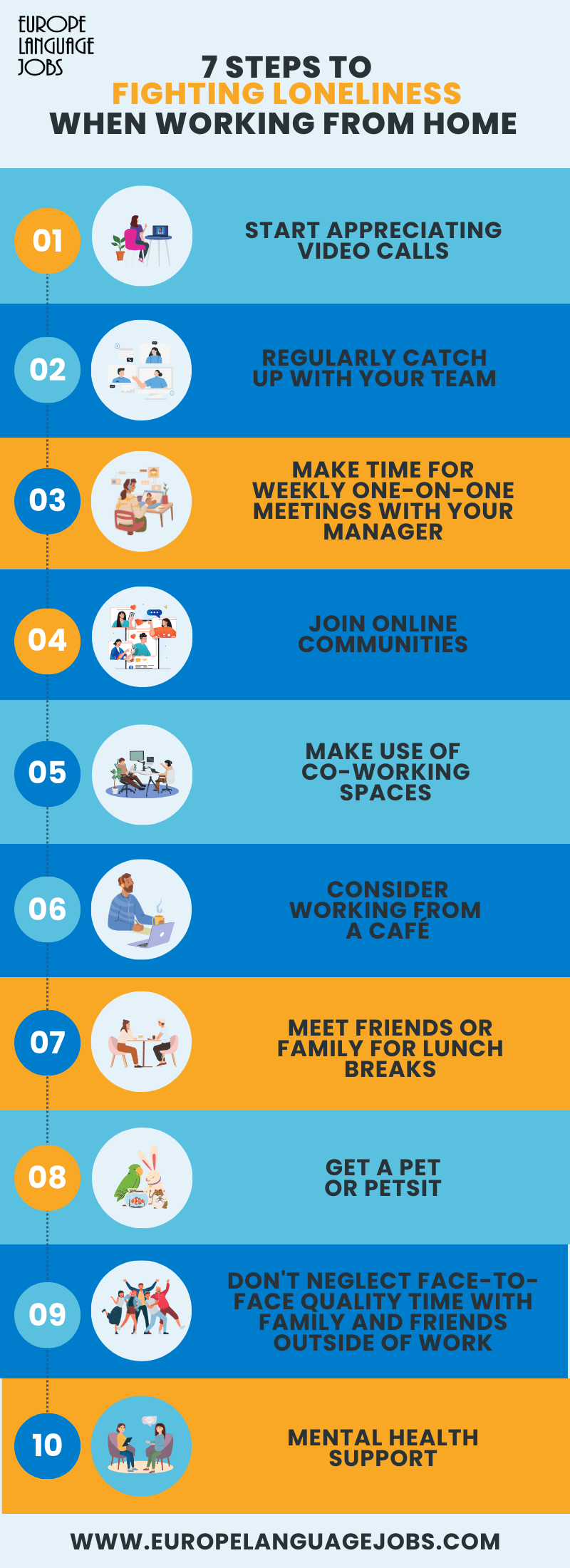Although remote work has many advantages, it can sometimes get isolating. Loneliness was named the second most common struggle of remote workers in research run by Buffer in collaboration with Nomad List and Remote OK.
23% of remote workers struggle with loneliness on a daily basis (Buffer). That means that almost one in four people working from the comfort of their own homes experience some level of isolation.
Of course, every style of working has its pros and cons. Adopting remote work gives us some perks while giving up certain comforts. One of those comforts is social interaction with coworkers when seeing them at the office every day.
Switching to working from home is a personal choice - we embrace increased flexibility and independence at the cost of other conveniences. It is, however, completely normal to feel lonely when working remotely - especially if you live alone.
An initial reaction to feeling lonely when working from home might be guilt. After all, many dream about switching to a completely remote lifestyle, but not everyone has that possibility.
There is a common misconception that when we are blessed with something that is generally desired, we should not complain. We feel like we ought to “get it together” and focus on the benefits rather than the drawbacks, because many would give up a lot to be in our shoes.
But loneliness is a serious issue, and it shouldn’t be ignored. Appreciating the pros of something doesn’t mean disregarding all its cons.
The feeling of isolation lasting for extended periods is a severe danger to one’s mental health. It can leave a lasting impact on your well-being and have a negative effect on your overall quality of life.
When you face the issue of loneliness when working from home, don’t ignore it. There are many ways to combat this problem, and we will show you what steps you can take to fight the feeling of isolation while working remotely in this article.

How to deal with loneliness when working from home
- Start appreciating video calls
- Regularly catch up with your team
- Make time for weekly one-on-one meetings with your manager
- Join online communities
- Make use of co-working spaces
- Consider working from a café
- Get the most from your lunch breaks
- Get a pet
- Don't neglect face-to-face quality time with family and friends
- Mental health support

1. Start appreciating video calls
On many occasions, it might seem easier to send a quick message rather than call. But we should not resort only to written communication when working from home.
It is true that many everyday issues are too minor to take the time to call someone. If we called about every little thing, none of us would get any work done.
If we don’t see our colleagues or supervisors at the desk across ours, we don’t know if now is the right time to call, or maybe they are currently busy and it’s safer to drop a quick message they can read whenever they are free.
However, there are times when a text message isn’t enough. If your problem is urgent, they might not see it until it’s too late. Or maybe the situation is too complicated, and typing it all out would actually take up more time than making a quick call.
According to remote workers, their collaboration mostly happens via messaging apps (50%), and then emails (22%). Meetings fall in third place, with 19% (Buffer).
The statistics demonstrate that it is very easy to get used to texting when working from home. There may even be some days when you realise you haven’t spoken a single word throughout an entire remote workday. This makes it extremely likely to disregard the necessity of verbal communication.
Therefore, it is recommended to make at least one call a day when working from home. And when you do, try to make it a video call, if possible.
Hearing somebody’s voice on the other end of the line can be a big highlight. But seeing them is an entirely different story.
A video call is not ideal, but it is sometimes the closest you can get to regular face-to-face interaction when working remotely. Even the blurry image, annoying feedback, and creepy background noises are often preferable to not interacting with another human all day long.

2. Regularly catch up with your team
15% of remote workers report difficulties in collaboration and communication (Buffer). Team catch-ups are a step towards eradicating this issue.
When working from home, there will be some team members with whom you will be in touch on a daily basis more often than others. Even within one department, there are sometimes too many employees to regularly need something from every single one.
This is why it is crucial to make time for frequent catch-ups involving all of the team members. Your team leader should initiate them but if they don’t, feel free to suggest the idea to them.
Regular group video calls are a good way to keep the team spirit going and stay up-to-date with what everyone is currently working on. Nobody works in an isolated environment - all tasks are intertwined.
Members of a team are working towards a common goal, so it is beneficial for everyone to know where others are standing with their duties.
Team catch-ups are also a great opportunity for brainstorming and solving issues together. If someone needs help or is stuck, bringing it up in front of their colleagues might present them with a solution much quicker than trying to figure it out on their own.
If the entire team is working remotely, such meetings will be the only opportunity for everyone to come together. It might help resolve the issue of 40% of men and 28% of women feeling stressed about not being seen or heard in meetings due to working remotely (Owl Labs).
If your workplace adopts a mixed system, with some employees working remotely and others coming to the office, it is a chance for everyone working from home to feel included.
It is common to feel isolated knowing other members of your team regularly interact with one another in the office. Seeing them regularly doing catch-up meetings helps maintain the bonds and reminds that everyone is equally a part of the team.

3. Make time for weekly one-on-one meetings with your manager
Many managers implement a system of one-on-one meetings with every member of the team. They are an opportunity to share struggles, update on the progress of tasks, be assigned new duties, and have a small chat away from other colleagues.
These meetings usually don’t last longer than 10 or 15 minutes. It may not seem like a lot, but it is actually a big step towards battling loneliness when working from home.
First of all, it is a reminder that there is someone out there who cares about your well-being and to whom you can talk about any issues you are experiencing. Secondly, it motivates you to stay productive, as every week, you are supposed to share your progress.
Of course, one-on-one meetings and team catch-ups are difficult for the 19% of remote workers working across different time zones. In such a scenario, a video call in real time may not be possible.
If you find yourself in this situation, discuss the best possible solutions, both for you and your company, with your manager and boss.

4. Join online communities
The feeling of loneliness when working from home can be lessened when we connect with someone who feels the same way.
If you believe that your colleagues, family, and friends don't quite understand your experience and can't relate, find someone who does. Join groups for remote workers and become part of a community that shares your struggles.
Apart from understanding, you may receive helpful tips for dealing with loneliness when working from home. Maybe others have solutions you have never thought about?

5. Make use of co-working spaces
As remote work grows in popularity, more and more co-working spaces pop up. First, you could primarily find them in larger cities, but it is not impossible anymore to encounter them in smaller towns.
Working in a co-working space gives the illusion of working from the office, with one big advantage: you don't have to be there. You choose to be there.
Many switch to a remote lifestyle due to costly, time-consuming commute or not wanting to have to visit the office every day. The main difference between a co-working space and a traditional office is that you can choose how many times a week or a month you go there, or which one you go to. Perhaps the nearest co-working space is much closer to your home than your office used to be, saving you precious time in the car or on public transport.
There is also a sense of freedom to being able to choose whether or not you decide to visit a co-working space, or how often you do it. Contrary to an office, it is also entirely up to you for how long you stay there. You can come for 2 hours and spend the rest of the day working from home.
Not knowing other people working alongside you may be a disadvantage to some. Working in the company of your colleagues at an office can feel more comfortable for many people than being surrounded by strangers.
But switch it around: imagine how many networking opportunities this brings. There are always some regulars who will be frequenting a co-working space, just like you. After spotting each other across the room a few times, you may feel comfortable enough to connect.
In this way, a co-working space is a great way to network and meet new people, effectively fighting loneliness whe
n working from home.
It also gives you the opportunity to combat the number one issue named by 33% of remote workers: staying home too often because they don’t have enough reasons to leave (Buffer).
The one downside to using a co-working space is having to pay for using it. However, many institutions offer flexible plans, and you can expect to pay less if you only visit a few times a week.

6. Consider working from a café
If you’re suffering from loneliness when working from home and crave human interaction, visiting a café might be a solution to your problem.
Now, this might not be everyone’s cup of tea (pun fully intended). 50% of remote workers claim they find it easier to avoid distractions when working from home (Buffer).
Working from a café may not be the best solution for that group, as it provides a lot of interruptions your home doesn’t. People talking, dishes clattering, or the coffee machine making noises may make it impossible to focus and negatively impact their productivity.
However, 77% of those who feel less productive while working remotely say it’s because they find more distractions at home than they do at the office (Owl Labs). This means they generally don’t mind the general hum of conversation and buzz of background noises which is present both at the office and at a café.
This solution may be perfect for the group who find it more challenging to focus at home. It is cheaper than buying a monthly co-working space subscription. You only need to pay for coffee, tea, or whatever snack catches your eye.
It also provides an opportunity to be around people, helping to make you feel less isolated. Additionally, cafés are much more common than co-working spaces. They are available at literally every corner, so you can choose the closest one. If you happen to live quite far from any co-working spaces and don’t want to commute, a café 2 minutes away might be a great alternative.
Disadvantages
Of course, there are certain disadvantages to working from a café. It is not the best environment for conducting meetings and taking calls due to the noise and distracting background. The majority of other patrons are also in their leisure time and might not notice you’re at work.
While at a co-working space, everyone is busy and focused, many people come to a café to chat or hang out with friends. They might also bother you about silly things - a waiter asking if you’re finished with your drink, or another patron wanting to snatch the napkin holder from your table.
Therefore, a café is not the perfect working environment for everyday use. It may not even be ideal for staying there all day, but it is a great alternative to keep in mind when you feel lonely when working from home and need some human interaction.
Pro tip: There are apps out there which can help you. For example, Reef allows you to find laptop-friendly venues, where you can book a slot to make sure it's not crowded when you arrive! What's more, you can even make sure your table has access to an electric outlet to charge your laptop or phone.
The small subsription fee also lets you benefit from a free hot drink and attractive discounts on meals in visited venues. You can support the local economy and enjoy a hassle-free workday from a nearby café or restaurant!

7. Get the most from your lunch breaks
The lunch break is your “you” time. When working from home, it is very easy to spend it in front of your computer, typing away or taking calls.
However, the truth is that the lunch break is especially important for remote workers. When you don’t get any human interaction all day, this is the time when you can catch up.
You can make plans to meet with a friend or family member for lunch. If their lunch break aligns with yours and they live close by, you can go out to a restaurant, have a meal together at home, or even enjoy some subscription meals. Subscription meals can be a convenient way to try new dishes and enjoy quality time without the hassle of cooking, allowing you to make the most of your social time during lunch breaks.
Another great practice is to use part of your lunch break to go for a walk. It doesn’t have to take up your entire break - first and foremost, you should eat something.
If you finish having lunch with a quarter to spare, go for a quick stroll around the block. It will allow you to get some fresh air, spend some time among people, disconnect from your tasks, and come back to them with a clear mind.
It seems like a small thing, but you would be surprised how leaving work behind for as little as half an hour could have an enormous effect on your productivity.

8. Get a pet
Perhaps a pet can't offer the level of interaction a human would. But trust us that pets are the best cure for loneliness.
On days when you feel lonely working from home, you can pet them, cuddle them, or just look at them and feel their presence, depending on the pet you choose.
Of course, pets are not just here for your convenience - they are a big responsibility. Just like having children, getting a pet can flip your lifestyle upside down and bring substantial changes. But we promise it's worth it!
If you can't own a pet, you can always petsit somebody else's. There are many people who can't work from home and need someone to walk their dogs throughout the day, or who travel frequently and need a safe temporary home for their cat/hamster/lizard.
Ask among friends and join groups where people in your area publish announcements about looking for someone to take care of their pets.

9. Don’t neglect face-to-face quality time with family and friends
If you live with your family, this may somehow reduce the feeling of loneliness when working from home. However, your family members are likely at work or school during the day, leaving you alone most of the time.
Sharing your house or flat with someone helps minimalise the feeling of isolation, as you do get to spend some time together in the evenings. But the issue gets much more complicated if you live on your own.
These days, we all tend to meet with family and friends less often than we used to in favour of staying in touch over the phone. But when faced with loneliness when working from home, you should attempt more than ever to initiate face-to-face meetings.
Keep finding reasons to go out of the house after work. Invite people over. Go out, have game nights, throw and attend dinner parties.
If you have moved away from your family and haven’t made new friends yet, look for ways to meet people. Language courses, sports activities, book clubs, or Facebook groups are some of the easiest and best ways to socialise.
Even if you are an introvert and are happy keeping social interactions to a minimum, do make sure to stay in touch with people. Loneliness has the nasty habit of creeping up on you unnoticed, and before you know it, the feeling of isolation could start bringing you down.

10. Mental health support
Loneliness is one of the most potent destabilisers of our mental health. As humans, we are herd animals. We need social interaction to function properly - even if we are introverts or generally feel comfortable in our own company.
Extended periods of forced loneliness can result in a lowered mood and ultimately lead to severe disorders, such as anxiety or depression. If you feel like working from home is getting to you, don't hesitate to reach out for help.
A qualified therapist can teach you how to effectively deal with loneliness and show you ways to avoid getting lonely. Just a few sessions can help you feel so much better and bring you much-needed relief.
To conclude, working at home doesn’t have to feel lonely all the time. There are steps you can take to eliminate the impression of being isolated. Let your friends and family know if you encounter issues, so that they can fully understand you need their company in your free time more than ever.
If implementing the methods discussed in the article doesn’t work, consider whether a remote job is the right choice for you. It’s all right to admit that what seemed attractive at first turned out not to fulfil your expectations.
If you don’t want to resign from remote work but struggle with loneliness when working from home, try switching to a hybrid mode. Visiting the office a few times a week might just be what will charge your social batteries and help you appreciate the work-from-home days more.
It’s all about being honest with yourself and communicating your needs to your employer. Many companies offer flexible working arrangements these days, so feel free to experiment until you find the one you feel the most comfortable in.
Check out the hybrid jobs and fully remote positions at Europe Language Jobs!
Resources:
-
State of Remote Work 2022. Owl Labs & Global Workplace Analytics
-
State of Remote Work 2023. Buffer, Nomad List & Remote OK
Feeling inspired? Visit our blog for more career advice! How can you be sure the information we provide is top-notch? We are a group of professionals working with recruiters, career coaches, and HR specialists from all over the world!
Trust our experience and let us help you find a new job in Europe!
















Lucas Bodor1y ago
Useful advice :)
Useful advice :)